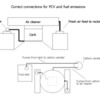...Now here is a question I have had for some time. All of our Panteras came with the Positive Crankcase Ventilation! I have studied every engine (picture) that I can find; and it seems to be half and half, with and without, the PCV hose and little check valve (that rattles when shaken). My question is, What exactly is the difference?? Is it NOT a vacumn Leak? When I disconnect and plug the PCV hose on my new engine there is NO noticable 'change' in the idle or the vacumn reading on the gauge; But on my old (original) engine, doing this would cause an substantial increase in the idle RPM. Is it possible to have the wrong check valve; are they different from one another. I have heard that the PCV will keep the engine cleaner!?? But it IS putting oil fumes into the intake charge! I can 'see' where the Negitive Pressure could help in the Longevity of the crankshaft seals. Please 'come-back' with Your experiences and what You have learned from your testing. I am now running WITH the PCV. Thanks To All...
Original Post


